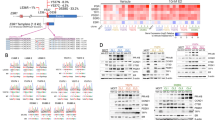Summary
Measurements of the estrogen receptor (ER) and the estrogen-induced progesterone receptor (PgR) are used by most clinicians as indicators of both overall prognosis and likelihood of response to endocrine therapy. Patients with ER+/PgR+ tumors have the highest likelihood of response; conversely, patients with ER-/PgR- tumors have the lowest likelihood of response. Unfortunately, most patients treated successfully with endocrine therapy eventually develop endocrine-resistant disease recurrence. In an effort to study potential mechanisms of endocrine resistance, we have studied discordant ER-/PgR+ tumors, in which the normally estrogen-regulated PgR gene is induced in the apparent absence of ER. Our laboratory has previously cloned, from ER-/PgR+ tumors, a variant ER mRNA precisely missing the sequence corresponding to ER exon 5, and has demonstrated that the truncated protein product translated from this variant RNA is capable of constitutively inducing the expression of an estrogen-responsive reporter gene in a yeast expression vector system (Fuqua et al, Cancer Res 51:105-109, 1991). In the present report we describe further experiments to characterize the activity and biological consequences of expression of this variant ER in human breast cancer cells. We have stably transfected MCF-7 human breast cancer cells with a mammalian expression vector for the exon 5 deletion variant ER. These transfected cells produce a truncated ER protein of the expected 40 kDa size. Cells expressing the exon 5 ER deletion variant constitutively express PgR, and manifest increased anchorage-independent colony formation in the absence of estrogen. Furthermore, the anchorage-dependent growth of these cells was not inhibited by the triphenylethylene antiestrogens tamoxifen or 4-hydroxytamoxifen, unlike MCF-7 cells transfected with a control plasmid, which were growth inhibited by both of these compounds. Interestingly, the pure antiestrogen ICI 164,384 did inhibit the growth of exon 5 ER deletion variant-expressing transfectants. The implications of these results with regard to the treatment of tamoxifen-resistant disease are discussed.
Similar content being viewed by others
References
Jensen EV, Jacobson HI: Basic guides to the mechanism of estrogen action. Recent Prog Horm Res 18:387–414, 1962
McGuire WL: Hormone receptors: their role in predicting prognosis and response to endocrine therapy. Semin Oncol 5:428–433, 1978
Jordan VC, Wolf MF, Mirecki DM, Whitford DA, Welshons WV: Hormone receptor assays: clinical usefulness in the management of carcinoma of the breast. CRC Crit Rev Clin Lab Sci 26:97–152, 1988
Horwitz KB, McGuire WL, Pearson OH, Segaloff A: Predicting response to endocrine therapy in human breast cancer: A hypothesis. Science 189:726–727, 1975
Clark GM, McGuire WL: Progesterone receptors and human breast cancer. Breast Cancer Res Treat 3: 157–163, 1983
Fuqua SAW, Fitzgerald SD, Chamness GC, Tandon AK, McDonnell DP, Nawaz Z, O'Malley BW, McGuire WL: Variant human breast tumor estrogen receptor with constitutive transcriptional activity. Cancer Res 51:105–109, 1991
Castles CG, Fuqua SAW, Klotz DM, Hill SM: Expression of a constitutively active estrogen receptor variant in the estrogen receptor-negative BT-20 human breast cancer cell line. Cancer Res 53:5934–5939, 1993
Clarke R, Brünner N, Katz D, Glanz P, Dickson RB, Lippman ME, Kern FG: The effects of a constitutive expression of transforming growth factor-α on the growth of MCF-7 human breast cancer cellsin vitro andin vivo. Mol Endocrinol 3:372–380, 1989
Tandon AK, Clark GM, Chamness GC, Ulrich A, McGuire WL: HER-2/neu oncogene protein and prognosis in breast cancer. J Clin Oncol 7:1120–1128, 1989
Smith PK, Krohn RI, Hermanson GT, Mallia AK, Gartner FH, Provenzano MD, Fukimoto EK, Goeke NM, Olson BJ, Klenk DC: Measurement of protein using bicinchoninic acid. Anal Biochem 150:76–85, 1985
Laemmli UK: Cleavage of structural proteins during assembly of the head of bacteriophage T4. Nature 227:680–685, 1970
King WJ, Greene GL: Monoclonal antibodies localize oestrogen receptors in the nuclei of target cells. Nature 307:745–747, 1984
Greene GL, Sobel N, King WJ, Jensen EJ: Immunochemical studies of estrogen receptors. J Steroid Biochem 20:51–56, 1984
Tandon AK, Chamness GC, McGuire WC: Estrogen receptor in very small breast tumor specimens: a modified charcoal-gelatin assay. Cancer Res 46: 3375–3377, 1986
Tandon AK, Chamness GC, McGuire WL: Progesterone receptor assays in low-protein cytosols: a modified charcoal-gelatin procedure. J Steroid Biochem 24:1135–1140, 1986
Kaneko KJ, Furlow JD, Gorski J: Involvement of the coding sequence for the estrogen receptor gene in autologous ligand-dependent down-regulation. Mol Endocrinol 7:879–888, 1993
Zhang Q-X, Borg A, Fuqua SAW: An exon 5 deletion variant of the estrogen receptor frequently coexpressed with wild-type estrogen receptor in human breast cancer. Cancer Res 53:5882–5884, 1993
Ciocca DR, Fuqua SAW, Lock-Lim S, Toft DO, Welch WJ, McGuire WL: Response of human breast cancer cells to heat shock and chemotherapeutic drugs. Cancer Res 52:3648–3654, 1992
Oesterreich S, Weng C-N, Qiu M, Hilsenbeck SG, Osborne CK, Fuqua SAW: The small heat shock protein hsp27 is correlated with growth and drug resistance in human breast cancer cell lines. Cancer Res 53:4443–4448, 1993
Author information
Authors and Affiliations
Rights and permissions
About this article
Cite this article
Fuqua, S.A.W., Wolf, D.M. Molecular aspects of estrogen receptor variants in breast cancer. Breast Cancer Res Tr 35, 233–241 (1995). https://doi.org/10.1007/BF00665974
Issue Date:
DOI: https://doi.org/10.1007/BF00665974




